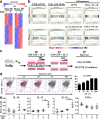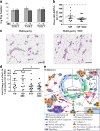Ibuprofen supports macrophage differentiation, T cell recruitment, and tumor suppression in a model of postpartum breast cancer
- PMID: 30285905
- PMCID: PMC6167844
- DOI: 10.1186/s40425-018-0406-y
Ibuprofen supports macrophage differentiation, T cell recruitment, and tumor suppression in a model of postpartum breast cancer
Abstract
Background: Women diagnosed with breast cancer within 5 years postpartum (PPBC) have poorer prognosis than age matched nulliparous women, even after controlling for clinical variables known to impact disease outcomes. Through rodent modeling, the poor prognosis of PPBC has been attributed to physiologic mammary gland involution, which shapes a tumor promotional microenvironment through induction of wound-healing-like programs including myeloid cell recruitment. Previous studies utilizing immune compromised mice have shown that blocking prostaglandin synthesis reduces PPBC tumor progression in a tumor cell extrinsic manner. Given the reported roles of prostaglandins in myeloid and T cell biology, and the established importance of these immune cell populations in dictating tumor growth, we investigate the impact of involution on shaping the tumor immune milieu and its mitigation by ibuprofen in immune competent hosts.
Methods: In a syngeneic (D2A1) orthotopic Balb/c mouse model of PPBC, we characterized the impact of mammary gland involution and ibuprofen treatment on the immune milieu in tumors and draining lymph nodes utilizing flow cytometry, multiplex IHC, lipid mass spectroscopy and cytokine arrays. To further investigate the impact of ibuprofen on programming myeloid cell populations, we performed RNA-Seq on in vivo derived mammary myeloid cells from ibuprofen treated and untreated involution group mice. Further, we examined direct effects of ibuprofen through in vitro bone marrow derived myeloid cell cultures.
Results: Tumors implanted into the mammary involution microenvironment grow more rapidly and display a distinct immune milieu compared to tumors implanted into glands of nulliparous mice. This milieu is characterized by increased presence of immature monocytes and reduced numbers of T cells and is reversed upon ibuprofen treatment. Further, ibuprofen treatment enhances Th1 associated cytokines as well as promotes tumor border accumulation of T cells. Safety studies demonstrate ibuprofen does not impede gland involution, impact subsequent reproductive success, nor promote auto-reactivity as detected through auto-antibody and naïve T cell priming assays.
Conclusions: Ibuprofen administration during the tumor promotional microenvironment of the involuting mammary gland reduces overall tumor growth and enhances anti-tumor immune characteristics while avoiding adverse autoimmune reactions. In sum, these studies implicate beneficial prophylactic use of ibuprofen during the pro-tumorigenic window of mammary gland involution.
Keywords: Ibuprofen; Macrophages; Multiplex IHC; NSAIDs; Postpartum breast cancer; T cells; Tumor microenvironment.
Conflict of interest statement
Ethics approval and consent to participate
All procedures and methodologies involving mice were approved by institutional IACUC committees of the University of Colorado and Oregon Health and Science University in compliance with NIH guidelines and accepted AALAC recommendations. All represented human gene expression and outcomes data was obtained deidentified from public databases in accordance with institutional review board and health information privacy policies governing the collection and distribution of data from The Cancer Genome Atlas (TCGA).
Consent for publication
Not applicable.
Competing interests
The authors declare that they have no competing interests.
Publisher’s Note
Springer Nature remains neutral with regard to jurisdictional claims in published maps and institutional affiliations.
Figures









Similar articles
-
Wound healing-like immune program facilitates postpartum mammary gland involution and tumor progression.Int J Cancer. 2015 Apr 15;136(8):1803-13. doi: 10.1002/ijc.29181. Epub 2014 Sep 15. Int J Cancer. 2015. PMID: 25187059 Free PMC article.
-
Non-steroidal anti-inflammatory drugs target the pro-tumorigenic extracellular matrix of the postpartum mammary gland.Int J Dev Biol. 2011;55(7-9):745-55. doi: 10.1387/ijdb.113379jo. Int J Dev Biol. 2011. PMID: 22161831
-
Physiologically activated mammary fibroblasts promote postpartum mammary cancer.JCI Insight. 2017 Mar 23;2(6):e89206. doi: 10.1172/jci.insight.89206. JCI Insight. 2017. PMID: 28352652 Free PMC article.
-
Mammary gland involution as an immunotherapeutic target for postpartum breast cancer.J Mammary Gland Biol Neoplasia. 2014 Jul;19(2):213-28. doi: 10.1007/s10911-014-9322-z. Epub 2014 Jun 22. J Mammary Gland Biol Neoplasia. 2014. PMID: 24952477 Free PMC article. Review.
-
Macphatics and PoEMs in Postpartum Mammary Development and Tumor Progression.J Mammary Gland Biol Neoplasia. 2020 Jun;25(2):103-113. doi: 10.1007/s10911-020-09451-6. Epub 2020 Jun 13. J Mammary Gland Biol Neoplasia. 2020. PMID: 32535810 Free PMC article. Review.
Cited by
-
Computationally repurposing drugs for breast cancer subtypes using a network-based approach.BMC Bioinformatics. 2022 Apr 20;23(1):143. doi: 10.1186/s12859-022-04662-6. BMC Bioinformatics. 2022. PMID: 35443626 Free PMC article.
-
Postpartum Involution and Cancer: An Opportunity for Targeted Breast Cancer Prevention and Treatments?Cancer Res. 2020 May 1;80(9):1790-1798. doi: 10.1158/0008-5472.CAN-19-3448. Epub 2020 Feb 19. Cancer Res. 2020. PMID: 32075799 Free PMC article. Review.
-
Nonsteroidal Anti-Inflammatory Drugs Reduce Second Cancer Risk in Patients With Breast Cancer: A Nationwide Population-Based Propensity Score-Matched Cohort Study in Taiwan.Front Oncol. 2021 Nov 24;11:756143. doi: 10.3389/fonc.2021.756143. eCollection 2021. Front Oncol. 2021. PMID: 34900705 Free PMC article.
-
Characterization of weaning-induced breast involution in women: implications for young women's breast cancer.NPJ Breast Cancer. 2020 Oct 16;6:55. doi: 10.1038/s41523-020-00196-3. eCollection 2020. NPJ Breast Cancer. 2020. PMID: 33083533 Free PMC article.
-
CCL8 Promotes Postpartum Breast Cancer by Recruiting M2 Macrophages.iScience. 2020 Jun 26;23(6):101217. doi: 10.1016/j.isci.2020.101217. Epub 2020 Jun 1. iScience. 2020. PMID: 32535027 Free PMC article.
References
-
- Azim HA, et al. Prognosis of pregnancy-associated breast cancer: a meta-analysis of 30 studies. Cancer Treat. Rev. 2012;38:834–842. - PubMed
Publication types
MeSH terms
Substances
Grants and funding
LinkOut - more resources
Full Text Sources
Medical
Molecular Biology Databases
